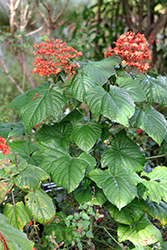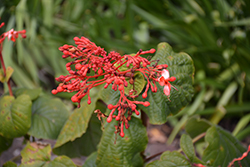Fri & Sat 8am - 8pm
Sun 8am - 7pm
Anytown, USA 12345
fax: 261.787.0463
e-mail: info@successgc.com


Plant Finder

Height: 6 feet
Spread: 6 feet
Sunlight:
![]()
![]()
Hardiness Zone: (annual)
Other Names: Clerodendron, Giant Salvia, syn. C. fallax
Description:
A vigorously growing, tropical shrub that presents large, bright panicles of orange-red flowers in late spring, over attractive heart shaped leaves; does best with some shade at midday; does not tolerate frost, but may re-sprout from the roots
Ornamental Features
Java Glorybower features showy panicles of fragrant orange star-shaped flowers with red overtones at the ends of the branches from late spring to mid summer, which emerge from distinctive coral-pink flower buds. Its attractive large tomentose heart-shaped leaves remain dark green in color with curious grayish green undersides throughout the year. The burgundy stems can be quite attractive.
Landscape Attributes
Java Glorybower is a multi-stemmed annual with an upright spreading habit of growth. Its relatively coarse texture can be used to stand it apart from other garden plants with finer foliage.
This plant will require occasional maintenance and upkeep, and should only be pruned after flowering to avoid removing any of the current season's flowers. It is a good choice for attracting birds, bees and butterflies to your yard. Gardeners should be aware of the following characteristic(s) that may warrant special consideration;
- Suckering
- Invasive
Java Glorybower is recommended for the following landscape applications;
- Accent
- Hedges/Screening
- General Garden Use
- Naturalizing And Woodland Gardens
- Container Planting
Planting & Growing
Java Glorybower will grow to be about 6 feet tall at maturity, with a spread of 6 feet. It has a low canopy with a typical clearance of 1 foot from the ground. Although it's not a true annual, this plant can be expected to behave as an annual in our climate if left outdoors over the winter, usually needing replacement the following year. As such, gardeners should take into consideration that it will perform differently than it would in its native habitat.
This plant does best in full sun to partial shade. It does best in average to evenly moist conditions, but will not tolerate standing water. It is not particular as to soil pH, but grows best in rich soils. It is somewhat tolerant of urban pollution. Consider applying a thick mulch around the root zone in winter to protect it in exposed locations or colder microclimates. This species is not originally from North America.
Java Glorybower is a fine choice for the garden, but it is also a good selection for planting in outdoor pots and containers. With its upright habit of growth, it is best suited for use as a 'thriller' in the 'spiller-thriller-filler' container combination; plant it near the center of the pot, surrounded by smaller plants and those that spill over the edges. It is even sizeable enough that it can be grown alone in a suitable container. Note that when growing plants in outdoor containers and baskets, they may require more frequent waterings than they would in the yard or garden.

